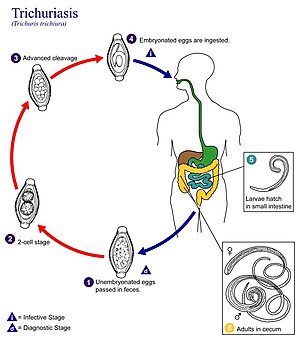鞭虫病
鞭蟲病(Trichuriasis),是由一種名為毛首鞭形线虫(Trichuris trichiura)的寄生蟲感染所導致的疾病[1]。疾病的症狀取決於患者體內的鞭蟲數量,如果只感染很少量的蟲,常常不會有顯著症狀[2],但若感染蟲數很多,則會出現腹痛、疲累和腹瀉等症狀[2]。當孩童感染時,可能會使孩童的智力和身體發展受到影響[2]。腹瀉有時候會帶有血,也因此會造成貧血[2]。也有可能有直腸脫垂的狀況[1]。
| 鞭蟲病 | |
|---|---|
 | |
| 鞭蟲的生命週期 | |
| 症状 | 肚痛、腹瀉、低色素性貧血[*]、嗜酸性粒细胞增多[*]、减肥 |
| 类型 | nematode infection[*]、土壤傳播蠕蟲病疫[*]、蠕蟲感染、小腸病變[*]、疾病 |
| 病因 | 鞭蟲 |
| 分类和外部资源 | |
| 醫學專科 | 傳染病學 |
| ICD-11 | 1F6G |
| ICD-10 | B79 |
| ICD-9-CM | 127.3 |
| DiseasesDB | 31146 |
| MedlinePlus | 001364 |
| eMedicine | 788570 |
| MeSH | D014257 |
鞭蟲病屬於土壤媒介的蠕蟲病,這個疾病通常藉由含有鞭蟲卵的飲水或食物傳播,像是食用含有蟲卵卻沒有清洗乾淨或未烹煮過的蔬菜[2]。鞭蟲的蟲卵常隨受感染者的糞便排至體外,常見於人們在戶外隨地大便、以及用未處理過的人類糞便作為肥料地區的土壤中[1]。小孩若在這樣的土地上玩耍,又將手放到嘴巴裡,很容易被感染[2]。鞭蟲的成蟲會寄生在大腸,長度約4公分[1]。通常藉由以顯微鏡觀察糞便檢體尋找蟲卵,蟲卵特徵為桶狀外觀且兩端有突出的透明卵塞,來診斷是否受鞭蟲寄生[3][4]。鞭虫病屬於土壤传播的蠕虫病。
藉由適當的烹煮食物和烹飪前洗手可以預防鞭蟲病。其他的預防方式包括改善衛生[5],例如:使用乾淨的沖水馬桶[5]和乾淨的水源[6]。疫區的人可能會集體感染,故需要同時接受治療[7]。鞭蟲病常使用的藥物有:阿苯達唑、甲苯咪唑或是伊維菌素[8],療程約三天。鞭蟲病在患者痊癒後可能會再次感染[9]。
鞭蟲感染影響全世界大約6億到8億的人口[1][10]。鞭蟲病普遍分布於熱帶國家[7],在開發中國家中,被鞭蟲感染的病患通常也會被鉤蟲與蛔蟲所感染[7],這些病原體對許多國家的經濟有很大的影響[11],目前對抗鞭蟲病的疫苗正在研發中[7]。鞭蟲病也是易被忽視的熱帶疾病之一[12]。
參考資料
编辑- ^ 1.0 1.1 1.2 1.3 1.4 Parasites - Trichuriasis (also known as Whipworm Infection). CDC. January 10, 2013 [5 March 2014]. (原始内容存档于2016-05-10).
- ^ 2.0 2.1 2.2 2.3 2.4 2.5 Soil-transmitted helminth infections Fact sheet N°366. World Health Organization. June 2013 [5 March 2014]. (原始内容存档于2014-02-21).
- ^ Parasites - Trichuriasis (also known as Whipworm Infection) Diagnosis. CDC. January 10, 2013 [20 March 2014]. (原始内容存档于2016-05-28).
- ^ Duben-Engelkirk, Paul G. Engelkirk, Janet. Laboratory diagnosis of infectious diseases : essentials of diagnostic microbiology. Baltimore: Wolters Kluwer Health/Lippincott Williams & Wilkins. 2008: 604 [2015-12-27]. ISBN 9780781797016. (原始内容存档于2014-11-29).
- ^ 5.0 5.1 Parasites - Trichuriasis (also known as Whipworm Infection) Prevention & Control. CDC. January 10, 2013 [20 March 2014]. (原始内容存档于2016-05-28).
- ^ Ziegelbauer, K; Speich, B; Mäusezahl, D; Bos, R; Keiser, J; Utzinger, J. Effect of sanitation on soil-transmitted helminth infection: systematic review and meta-analysis.. PLoS medicine. Jan 2012, 9 (1): e1001162. PMC 3265535 . PMID 22291577. doi:10.1371/journal.pmed.1001162.
- ^ 7.0 7.1 7.2 7.3 Bethony, J; Brooker, S; Albonico, M; Geiger, SM; Loukas, A; Diemert, D; Hotez, PJ. Soil-transmitted helminth infections: ascariasis, trichuriasis, and hookworm.. Lancet. May 6, 2006, 367 (9521): 1521–32. PMID 16679166. doi:10.1016/S0140-6736(06)68653-4.
- ^ Parasites - Trichuriasis (also known as Whipworm Infection): Resources for Health Professionals. CDC. January 10, 2013 [5 March 2014]. (原始内容存档于2018-12-08).
- ^ Jia, TW; Melville, S; Utzinger, J; King, CH; Zhou, XN. Soil-transmitted helminth reinfection after drug treatment: a systematic review and meta-analysis.. PLoS neglected tropical diseases. 2012, 6 (5): e1621. PMC 3348161 . PMID 22590656. doi:10.1371/journal.pntd.0001621.
- ^ Fenwick, A. The global burden of neglected tropical diseases.. Public health. Mar 2012, 126 (3): 233–6. PMID 22325616. doi:10.1016/j.puhe.2011.11.015.
- ^ Jamison, Dean. Helminth Infections: Soil-transmitted Helminth Infections and Schistosomiasis. Disease control priorities in developing countries 2nd ed. New York: Oxford University Press. 2006: Chapter 24 [2015-12-27]. ISBN 9780821361801. (原始内容存档于2016-10-10).
- ^ Neglected Tropical Diseases. cdc.gov. June 6, 2011 [28 November 2014]. (原始内容存档于2015-05-27).